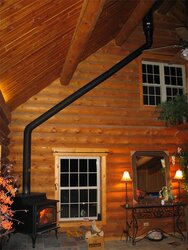I've been wondering about cathedral ceiling installations where there's 20 feet of pipe hanging off the ceiling box. How is this securely anchored? Our Duravent, latches into the ceiling box with a quarter turn I think. But with a super long run of heavy pipe, this doesn't inspire great confidence, especially in an earthquake region. I added long screws for additional peace of mind. Is this overkill or is it recommended to secure the pipe with more than just the box collar lock?
What supports the pipe?
- Thread starter begreen
- Start date
-
Active since 1995, Hearth.com is THE place on the internet for free information and advice about wood stoves, pellet stoves and other energy saving equipment.
We strive to provide opinions, articles, discussions and history related to Hearth Products and in a more general sense, energy issues.
We promote the EFFICIENT, RESPONSIBLE, CLEAN and SAFE use of all fuels, whether renewable or fossil.


